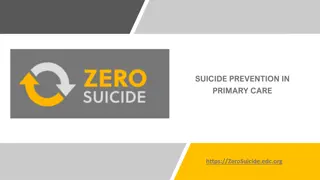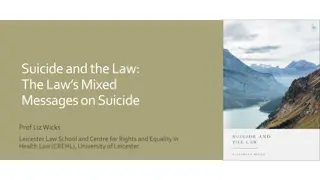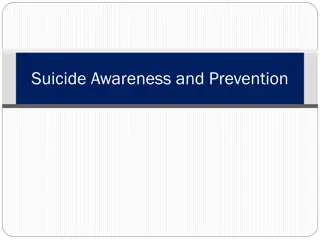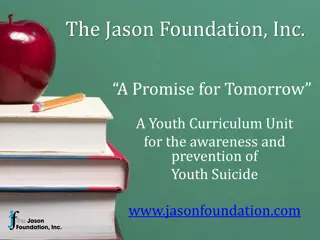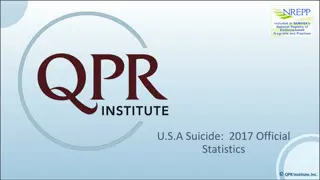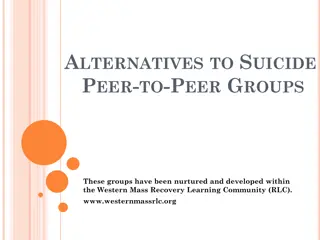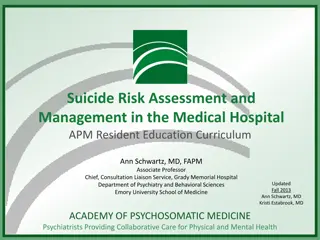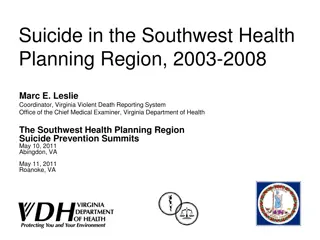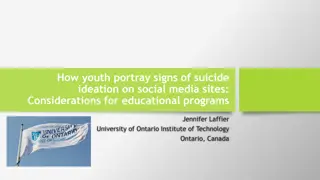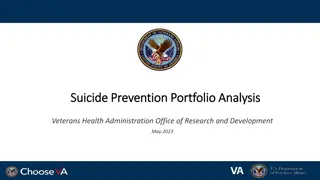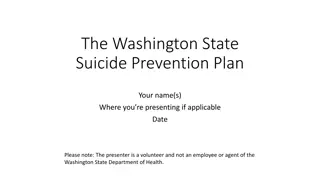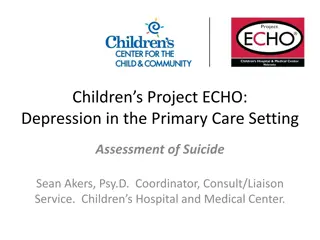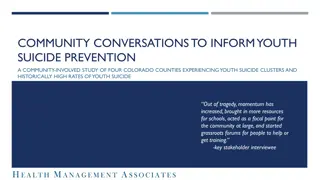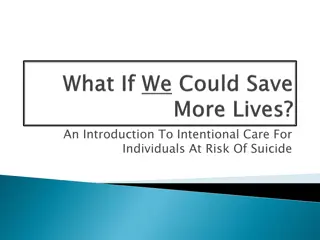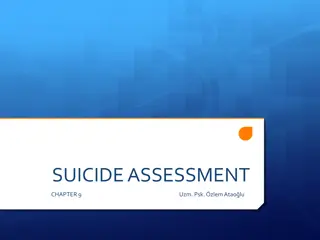Analysis of Suicide in the Northwest Health Planning Region (2003-2008)
The presentation discusses suicide data in the Northwest Health Planning Region from 2003 to 2008. It covers the number of suicides per year, suicide rates, comparison with homicide rates, demographics of suicide victims, and key findings from the region. Various statistics and visuals provide insights into the prevalence and characteristics of suicide in the area.
Download Presentation

Please find below an Image/Link to download the presentation.
The content on the website is provided AS IS for your information and personal use only. It may not be sold, licensed, or shared on other websites without obtaining consent from the author.If you encounter any issues during the download, it is possible that the publisher has removed the file from their server.
You are allowed to download the files provided on this website for personal or commercial use, subject to the condition that they are used lawfully. All files are the property of their respective owners.
The content on the website is provided AS IS for your information and personal use only. It may not be sold, licensed, or shared on other websites without obtaining consent from the author.
E N D
Presentation Transcript
Suicide in the Northwest Health Planning Region, 2003-2008 Marc E. Leslie Coordinator, Virginia Violent Death Reporting System Office of the Chief Medical Examiner, Virginia Department of Health Presented by Stephanie Goodman Injury Data and Evaluation Coordinator Office of Family Health Services, Virginia Department of Health The Northwest Health Planning Region Suicide Prevention Summits May 24, 2011 Harrisonburg, VA May 25, 2011 Fredericksburg, VA
Map of the Northwest Health Planning Region (HPR) Frederick Winchester Clarke Warren Shenandoah Fauquier Rappahannock Page Rockingham Culpeper Harrisonburg Stafford Madison Highland Fredericksburg Greene King George Orange Spotsylvania Augusta Staunton Waynesboro Bath Caroline Charlottesville Albemarle Louisa Rockbridge Fluvanna Lexington Nelson Buena Vista 2
Pop Quiz In the Northwest Health Planning Region: 1. Average number of suicides per year? (Hint: average of 32 homicides per year). 2. Percentage of suicide victims who are White males? 3. Median age of a suicide victim? 4. Percentage of male and female suicides by firearm? 3
Suicide in the Northwest HPR, 2003-2008 Overview of the Problem 4
Suicide in the Northwest HPR, 2003-2008 Number of Suicides by Year 170 163 165 160 160 Number of Suicides 152 155 150 148 150 145 139 140 136 135 130 125 120 Average 2003 2004 2005 2006 2007 2008 Year 5
Suicide in the Northwest HPR, 2003-2008 Suicide Rate by Year 16.0 13.6 13.6 13.4 12.9 12.6 14.0 12.4 12.1 Suicide Rate Per 100,000 12.0 12.0 10.0 11.4 11.3 11.3 11.2 11.0 10.8 8.0 6.0 4.0 2.0 0.0 Total 2003 2004 2005 2006 2007 2008 Year Northwest HPR Virginia 6
Suicide in the Northwest HPR, 2003-2008 Suicide vs. Homicide (2003-2008) 898 suicides; rate of 12.9 191 homicides; rate of 2.8 Suicide occurs 4.7 times more often than homicide 7
Suicide in the Northwest HPR, 2003-2008 Number of Non-Fatal Suicide Attempts by Year 1000 912 867 900 787 785 738 800 727 Number of Suicides 690 700 600 500 400 300 200 100 0 Average 2003 2004 2005 2006 2007 2008 Year 8
Suicide in the Northwest HPR, 2003-2008 Non-Fatal Suicide Attempt Rate by Year 75.8 72.7 80.0 Non-Fatal Suicide Rate Per 100,000 68.0 67.1 66.7 64.9 70.0 59.8 69.2 60.0 66.4 62.3 61.1 60.0 59.0 58.2 50.0 40.0 30.0 20.0 10.0 0.0 Total 2003 2004 2005 2006 2007 2008 Year Northwest HPR Virginia 9
Suicide in the Northwest HPR, 2003-2008 Who is at Risk? 10
Suicide in the Northwest HPR, 2003-2008 Selected Demographic Elements Gender Race Age 11
Suicide in the Northwest HPR, 2003-2008 Race and Gender Male (78%, rate of 20.5) White (93%, rate of 13.9) White male (73%, rate of 22.0) (remember, overall rate for Northwest HPR is 12.9) 12
Suicide in the Northwest HPR, 2003-2008 Age Median age is 47 Ages 45-54 most common age group (25%) and highest rate (22.8) Next highest rates for those 75-84 (rate of 20.7) and 85 and older (rate of 21.0) In general, as age increases, so does suicide rate 13
Suicide in the Northwest HPR, 2003-2008 Suicide Rate by Age Group 25.0 Suicide Rate Per 100,000 20.0 15.0 10.0 5.0 0.0 Age Group Northwest HPR Virginia 14
Suicide in the Northwest HPR, 2003-2008 Race and Gender: Non-Fatal Attempts Most commonly by females (62%, rate of 83.2) Whites still most common and highest risk; but Black risk level rises notably (from rate of 7.3 to 46.9) 15
Suicide in the Northwest HPR, 2003-2008 Fatal and Non-Fatal Suicide Rates by Gender 90.0 80.0 70.0 Rate Per 100,000 60.0 50.0 83.2 40.0 68.0 30.0 52.2 20.0 20.5 10.0 12.9 5.6 0.0 Total Male Female Gender Fatal Non-Fatal 16
Suicide in the Northwest HPR, 2003-2008 Age: Non-Fatal Attempts Median age is 34 Risk shifts from middle-age and older adults to children and youth Rate for those 15-19 years old is 120.6 In general, non-fatal attempt rate decreases with age 17
Suicide in the Northwest HPR, 2003-2008 Non-Fatal and Fatal Suicide Rate by Age Group 140.0 120.0 100.0 Rate Per 100,000 At ages 65-74, the fatal rate surpasses the non-fatal rate 80.0 60.0 40.0 20.0 0.0 Age Group Non-Fatal Fatal 18
Suicide in the Northwest HPR, 2003-2008 Veterans 19
Suicide in the Northwest HPR, 2003-2008 Veterans 24% of all suicide victims (18 years and older) 29% of males; 4% of all females Unknown if veterans served in combat, but can generally tell if they are currently in the military 20
Suicide in the Northwest HPR, 2003-2008 Veterans Male veterans older than male non-veterans (median ages of 61 and 44, respectively) Median age suggests that those who are combat veterans generally not in the most recent conflicts 63% of males ages 65 and over are veterans compared to 21% of males ages 18-64 21
Suicide in the Northwest HPR, 2003-2008 Method of Fatal Injury 22
Suicide in the Northwest HPR, 2003-2008 Method of Fatal Injury More than one method of fatal injury can be used per suicide (e.g., combining poison and drowning) Firearm, poison, and hanging/suffocation account for 95% of suicides Most poisons are prescribed medications, primarily mental health medications and pain medications 23
Suicide in the Northwest HPR, 2003-2008 Selected Methods by Gender 100.0 90.0 14.2 14.7 Percentage Using Method 14.8 80.0 14.7 70.0 21.9 60.0 47.7 Hanging/Suffocation Poison Firearm 50.0 40.0 65.3 30.0 58.5 20.0 34.0 10.0 0.0 Total Males Females Gender 24
Suicide in the Northwest HPR, 2003-2008 Method of Fatal Injury: Non-Fatal Attempts Most common method for non-fatal attempts is poison (82%) Poison use is defining method difference between fatal and non-fatal attempts 25
Suicide in the Northwest HPR, 2003-2008 Geography 26
Suicide in the Northwest HPR, 2003-2008 Geography Northwest HPR has 32 localities (24 counties and 8 cities) 23 of these localities (72%) have a suicide rate exceeding the rate for Virginia (11.3) In general smaller locality = lower number and higher rate 27
Suicide in the Northwest HPR, 2003-2008 # Rate # Rate Five Highest Suicide Rates Five Lowest Suicide Rates Rappahannock 12 27.8 Lexington 0 0.0 Waynesboro 27 21.2 Bath 1 3.5 Warren 44 20.7 Harrisonburg 16 6.4 Page 28 19.5 King George 12 9.5 Rockbridge 24 18.8 Stafford 68 9.6 28
Suicide in the Northwest HPR, 2003-2008 Frederick Winchester Rate per 100,000 Clarke 0 - 6 7 - 14 Warren 15 - 19 Shenandoah 20 - 28 Fauquier Rappahannock Page Rockingham Culpeper Harrisonburg Stafford Madison Highland Fredericksburg King George Greene Orange Spotsylvania Augusta Staunton Waynesboro Bath Caroline Charlottesville Albemarle Louisa Rockbridge Fluvanna Lexington Nelson Buena Vista 29
Suicide in the Northwest HPR, 2003-2008 Frederick Winchester Rate per 100,000 Clarke 0.0 - 11.3 11.4 - 27.8 Warren Shenandoah Fauquier Rappahannock Rockingham Page Culpeper Harrisonburg Stafford Madison Highland Fredericksburg King George Greene Orange Spotsylvania Augusta Staunton Waynesboro Bath Caroline Charlottesville Albemarle Louisa Rockbridge Fluvanna Lexington Nelson Buena Vista 30
Suicide in the Northwest HPR, 2003-2008 Selected Circumstances 31
Suicide in the Northwest HPR, 2003-2008 Most Common Circumstances Mental health problem (54%) Crisis in past two weeks (38%) Intimate partner problem (33%) Problem with alcohol and/or other substances (27%) Physical health problem (24%) 32
Suicide in the Northwest HPR, 2003-2008 Circumstances: Mental Health Females (76%) more than males (47%) Most prevalent in ages 35-44 (69%); 30% or more of every age group 80% treated in past two months and/or prior 68% known to take mental health medications currently or in the past* *2007-2008 data 33
Suicide in the Northwest HPR, 2003-2008 Circumstances: Crisis in Past 2 Weeks 38% of all persons; 40% of males, 32% of females Most crises (72%) occurred in the past 24 hours* Indicator of reactive suicides 50% or more for every age group through ages 25-34 *2007-2008 data 34
Suicide in the Northwest HPR, 2003-2008 Circumstances: Intimate Partner Problems 33% having problems with current/former intimate partner at time of suicide Similar for males and females 68% also having a recent life crisis Shows volatility of intimate partner conflict 35
Suicide in the Northwest HPR, 2003-2008 Intimate Partner Problems and Crisis by Age Group 100.0 Percentage with Circumstance 90.0 80.0 70.0 60.0 50.0 40.0 30.0 20.0 10.0 0.0 Age Group Intimate Partner Problem Crisis in Past 2 Weeks 36
Suicide in the Northwest HPR, 2003-2008 Circumstances: Alcohol and Other Substance Problems 27% of all persons Peaks at ages 35-44 (36%) 48% of those with alcohol problems had elevated levels of alcohol in their system (compared to 22% of those without alcohol problems) 37
Suicide in the Northwest HPR, 2003-2008 Circumstances: Physical Health Problems 24% of all suicide victims; no gender differences Median age of 64 compared to 44 for those without a physical health problem 75% or more of those ages 75-84 and 85 and older 38
Suicide in the Northwest HPR, 2003-2008 Circumstances: Physical Health Problems Explains majority of elder suicides Problems range from treatable (diabetes, mild pain) to severe (loss of vision, amputations) to terminal diseases and conditions 39
Suicide in the Northwest HPR, 2003-2008 Circumstances: Warning Signs 47% disclosed intent and/or had prior attempts Most commonly disclosed to intimate partners (58%), family (28%), or friends/acquaintances (21%)* *2007-2008 data 40
Suicide in the Northwest HPR, 2007-2008 Actions Taken to Prevent Suicide* Tried to persuade victim to not commit suicide (37%) Checked in on victim (27%) Called 911/law enforcement (20%) Sought/encouraged mental health treatment (17%) Limited access to firearms/ammunition (13%) *2007-2008 data (entire slide) 41
Suicide in the Northwest HPR, 2007-2008 Efforts to Limit Access to Firearms and/or Ammunition* 10 persons had friends or family members who restricted access to firearms or ammunition Includes 6 persons not known to disclose intent, but loved ones acted out of concern Variety of techniques used to restrict (hiding, removing, disassembling) Of these persons, all (100%) used a firearm to commit suicide 42 *2007-2008 data (entire slide)
Suicide in the Northwest HPR, 2003-2008 In the fatal suicide, those with prior attempts used less lethal methods than those without prior attempts No Prior Suicide Attempts Prior Suicide Attempts Other 4% Other 8% Hanging/ Suffocation 13% Firearm 29% Hanging/ Suffocation 23% Poison 18% Firearm 65% Poison 40% 43
Suicide in the Northwest HPR, 2007-2008 Other Warning Signs of Suicide* Taking prescribed pain medication (15%) Sleeping too little (8%) Unusual behavior, past two weeks (6%) Family history of suicide (4%) Family/friends expected suicide (3%) *2007-2008 data (entire slide) 44
Suicide in the Northwest HPR, 2003-2008 Conclusions Suicide rates are highest among Whites, males, and middle-aged and older adults Most suicides involve use of a firearm to inflict fatal injury Most suicide victims have a mental health problem, and most of these persons were being treated 45
Suicide in the Northwest HPR, 2003-2008 Conclusions Nearly half of suicide victims talk about plans or desire to commit suicide and/or have a history of suicide attempt(s) Fatal suicide and non-fatal suicide attempts present radically different pictures of risk and methods of fatal injury 46
Questions, Data Requests, Further Information Marc Leslie, VVDRS Coordinator 737 N. 5th Street, Suite 301 Richmond, VA 23219 804-205-3855 marc.leslie@vdh.virginia.gov http://www.vdh.virginia.gov/medExam/NVDRS.htm Our goal is to provide data and information that can be used for prevention and education; please let me know how I can help 47
Appendix: Additional Information and Complete Tables 48
Suicide in the Northwest HPR, 2003-2008 Index: Fatal Suicide Information Slide Information Slide Demographics Gender Race Ethnicity Race/Gender Age Group Veterans Male Age Group/Veteran Method of Fatal Injury Complete List of Methods Selected Methods by Age Categories of Poison Most Common Poisons Locality-Specific Number/Rate by Locality Circumstances Relationship Problems Life Stressors Alcohol/Other Substances Mental Health Warning Signs of Suicide Disclosed Intent Actions to Prevent Suicide Prior Suicide Attempts Other Warning Signs 51 51 51 52 53 62-64 65 65 66 67-68 56 69 70 57 58 59 60 71-72 73 74 49
Suicide in the Northwest HPR, 2003-2008 Index: Non-Fatal Suicide Information Slide Non-Fatal Suicide Gender Race Ethnicity Age Group Method of Fatal Injury Complete List of Methods 54 54 54 55 61 50


